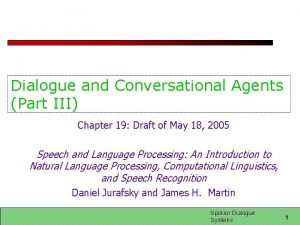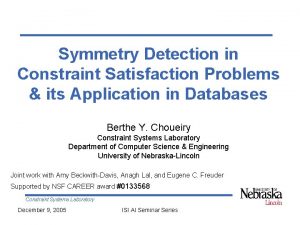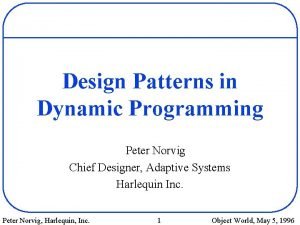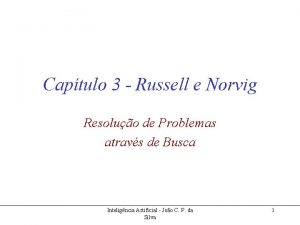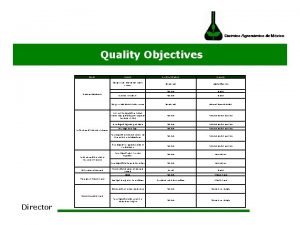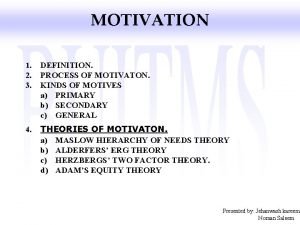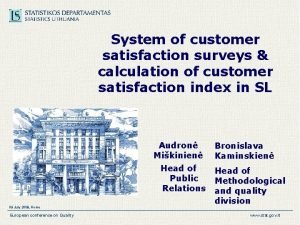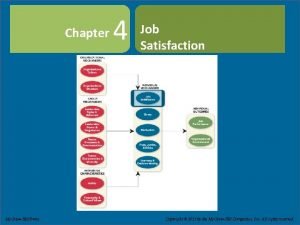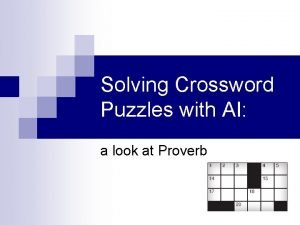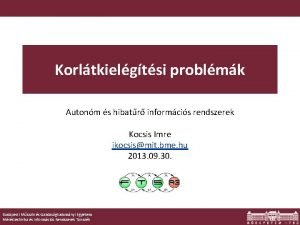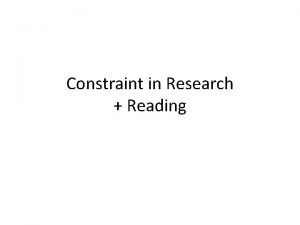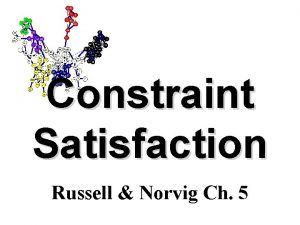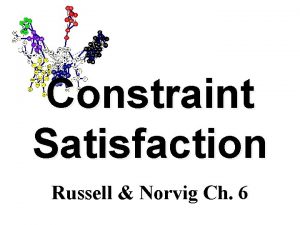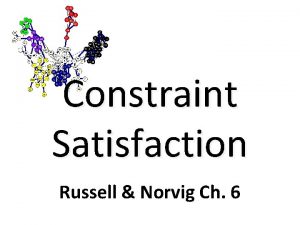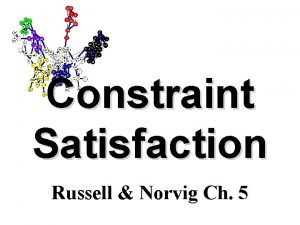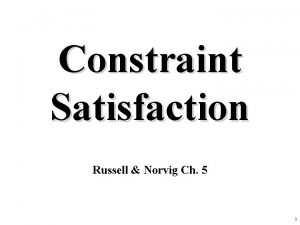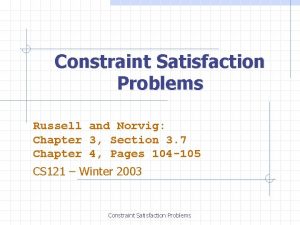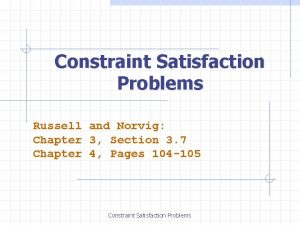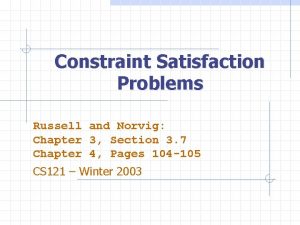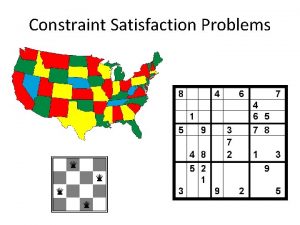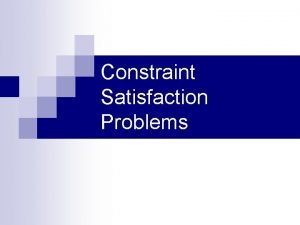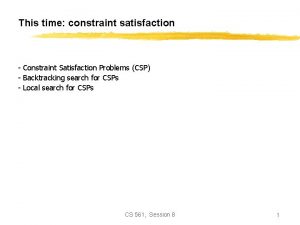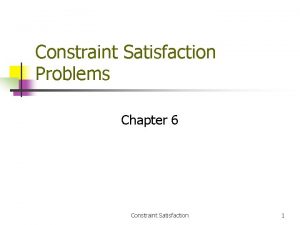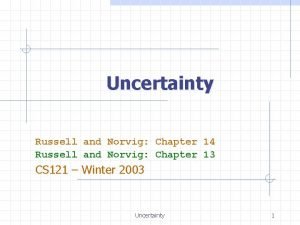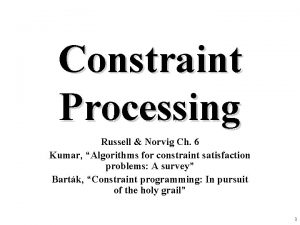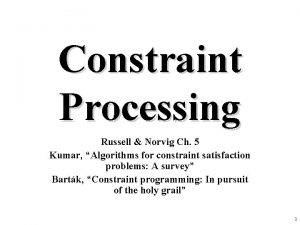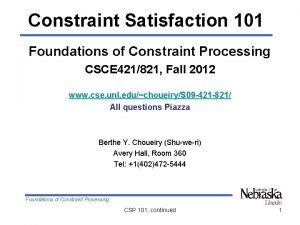Constraint Satisfaction Russell Norvig Ch 5 Overview Constraint















































































- Slides: 79

Constraint Satisfaction Russell & Norvig Ch. 5

Overview • Constraint satisfaction offers a powerful problemsolving paradigm – View a problem as a set of variables to which we have to assign values that satisfy a number of problemspecific constraints. – Constraint programming, constraint satisfaction problems (CSPs), constraint logic programming… • Algorithms for CSPs – Backtracking (systematic search) – Constraint propagation (k-consistency) – Variable and value ordering heuristics – Backjumping and dependency-directed backtracking

Motivating example: 8 Queens Place 8 queens on a chess board such That none is attacking another. Generate-and-test, with no redundancies “only” 88 combinations 8**8 is 16, 777, 216

Motivating example: 8 -Queens

What more do we need for 8 queens? • Not just a successor function and goal test • But also – a means to propagate constraints imposed by one queen on the others – an early failure test Explicit representation of constraints and constraint manipulation algorithms

Informal definition of CSP • CSP = Constraint Satisfaction Problem, given (1) a finite set of variables (2) each with a domain of possible values (often finite) (3) a set of constraints that limit the values the variables can take on • A solution is an assignment of a value to each variable such that the constraints are all satisfied. • Tasks might be to decide if a solution exists, to find a solution, to find all solutions, or to find the “best solution” according to some metric (objective function).

Example: 8 -Queens Problem • Eight variables Xi, i = 1. . 8 where Xi is the row number of queen in column i • Domain for each variable {1, 2, …, 8} • Constraints are of the forms: – Not on same row: Xi = k Xj k for j = 1. . 8, j i – Not on same diagonal Xi = ki, Xj = kj |i-j| | ki - kj| for j = 1. . 8, j i

Example: Task Scheduling T 1 T 2 T 4 T 3 Examples of scheduling constraints: • T 1 must be done during T 3 • T 2 must be achieved before T 1 starts • T 2 must overlap with T 3 • T 4 must start after T 1 is complete

Example: Map coloring Color the following map using three colors (red, green, blue) such that no two adjacent regions have the same color. E D A B C

Map coloring • Variables: A, B, C, D, E all of domain RGB • Domains: RGB = {red, green, blue} • Constraints: A B, A C, A E, A D, B C, C D, D E • A solution: A=red, B=green, C=blue, D=green, E=blue E D E A C B => D A C B

Brute Force methods • Finding a solution by a brute force search is easy – Generate and test is a weak method – Just generate potential combinations and test each • Potentially very inefficient – With n variables where each can have one of 3 values, there are 3 n possible solutions to check • There are ~190 countries in the world, which we can color using four colors • 4190 is a big number! solve(A, B, C, D, E) : color(A), color(B), color(C), color(D), color(E), not(A=B), not(B=C), not(A=C), not(C=D), not(A=E), not(C=D). color(red). color(green). color(blue). 4**190 is 2462625387274654950767440006258975862817483704404090416746768337765357610718575663213391640930307227550414249394176 L

Example: SATisfiability • Given a set of propositions containing variables, find an assignment of the variables to {false, true} that satisfies them. • For example, the clauses: – (A B C) ( A D) – (equivalent to (C A) (B D A) are satisfied by A = false, B = true, C = false, D = false • Satisfiability is known to be NP-complete, so in the worst case, solving CSP problems requires exponential time

Real-world problems CSPs are a good match for many practical problems that arise in the real world • • • Scheduling Temporal reasoning Building design Planning Optimization/satisfaction Vision • Graph layout • Network management • Natural language processing • Molecular biology / genomics • VLSI design

Definition of a constraint network (CN) A constraint network (CN) consists of • a set of variables X = {x 1, x 2, … xn} – each with associated domain of values {d 1, d 2, …dn} – the domains are typically finite • a set of constraints {c 1, c 2 … cm} where – each defines a predicate which is a relation over a particular subset of variables (X) – e. g. , Ci involves variables {Xi 1, Xi 2, … Xik} and defines the relation Ri Di 1 x Di 2 x … Dik

Unary and binary constraints most common Binary constraints NT WA T 1 Q T 2 NSW SA T 4 T 3 V T • Two variables are adjacent or neighbors if they are connected by an edge or an arc • It’s possible to rewrite problems with higher-order constraints as ones with just binary constraints

Formal definition of a CN • Instantiations – An instantiation of a subset of variables S is an assignment of a value in its domain to each variable in S – An instantiation is legal if and only if it does not violate any constraints. • A solution is an instantiation of all of the variables in the network.

Typical tasks for CSP • Solutions: – Does a solution exist? – Find one solution – Find all solutions – Given a metric on solutions, find the best one – Given a partial instantiation, do any of the above • Transform the CN into an equivalent CN that is easier to solve.

Binary CSP • A binary CSP is a CSP where all constraints are binary or unary • Any non-binary CSP can be converted into a binary CSP by introducing additional variables • A binary CSP can be represented as a constraint graph, which has a node for each variable and an arc between two nodes if and only there is a constraint involving the two variables – Unary constraints appear as self-referential arcs

A running example: coloring Australia NT Q WA NSW SA V T • Seven variables: {WA, NT, SA, Q, NSW, V, T} • Each variable has the same domain: {red, green, blue} • No two adjacent variables have the same value: WA NT, WA SA, NT Q, SA NSW, SA V, Q NSW, NSW V

A running example: coloring Australia NT WA Q NSW SA V T • Solutions are complete and consistent assignments • One of several solutions • Note that for generality, constraints can be expressed as relations, e. g. , WA ≠ NT is (WA, NT) in {(red, green), (red, blue), (green, red), (green, blue), (blue, red), (blue, green)}

Backtracking example

Backtracking example

Backtracking example

Backtracking example

Basic Backtracking Algorithm CSP-BACKTRACKING(Partial. Assignment a) – – If a is complete then return a X select an unassigned variable D select an ordering for the domain of X For each value v in D do If v is consistent with a then – Add (X= v) to a – result CSP-BACKTRACKING(a) – If result failure then return result – Remove (X= v) from a – Return failure Start with CSP-BACKTRACKING({}) Note: this is depth first search; can solve n-queens problems for n ~ 25

Problems with backtracking • Thrashing: keep repeating the same failed variable assignments – Consistency checking can help – Intelligent backtracking schemes can also help • Inefficiency: can explore areas of the search space that aren’t likely to succeed – Variable ordering can help

Improving backtracking efficiency Here are some standard techniques to improve the efficiency of backtracking – Can we detect inevitable failure early? – Which variable should be assigned next? – In what order should its values be tried?

Forward Checking After a variable X is assigned a value v, look at each unassigned variable Y connected to X by a constraint and delete from Y’s domain values inconsistent with v Using forward checking and backward checking roughly doubles the size of N-queens problems that can be practically solved

Forward checking • Keep track of remaining legal values for unassigned variables • Terminate search when any variable has no legal values

Forward checking

Forward checking

Forward checking

Constraint propagation • Forward checking propagates info. from assigned to unassigned variables, but doesn't provide early detection for all failures. • NT and SA cannot both be blue!

Definition: Arc consistency • A constraint C_xy is said to be arc consistent wrt x if for each value v of x there is an allowed value of y • Similarly, we define that C_xy is arc consistent wrt y • A binary CSP is arc consistent iff every constraint C_xy is arc consistent wrt x as well as y • When a CSP is not arc consistent, we can make it arc consistent, e. g. , by using AC 3 – This is also called “enforcing arc consistency”

Arc Consistency Example • Domains – D_x = {1, 2, 3} – D_y = {3, 4, 5, 6} • Constraint – C_xy = {(1, 3), (1, 5), (3, 3), (3, 6)} • C_xy is not arc consistent wrt x, neither wrt y. By enforcing arc consistency, we get reduced domains – D'_x = {1, 3} – D'_y={3, 5, 6}

Arc consistency • Simplest form of propagation makes each arc consistent • X Y is consistent iff for every value x of X there is some allowed y

Arc consistency • Simplest form of propagation makes each arc consistent • X Y is consistent iff for every value x of X there is some allowed y

Arc consistency If X loses a value, neighbors of X need to be rechecked

Arc consistency • Arc consistency detects failure earlier than simple forward checking • Can be run as a preprocessor or after each assignment

General CP for Binary Constraints Algorithm AC 3 contradiction false Q stack of all variables while Q is not empty and not contradiction do X UNSTACK(Q) For every variable Y adjacent to X do If REMOVE-ARC-INCONSISTENCIES(X, Y) If domain(Y) is non-empty then STACK(Y, Q) else return false

Complexity of AC 3 • • e = number of constraints (edges) d = number of values per variable Each variable is inserted in Q up to d times REMOVE-ARC-INCONSISTENCY takes O(d 2) time • CP takes O(ed 3) time

Improving backtracking efficiency • Here are some standard techniques to improve the efficiency of backtracking – Can we detect inevitable failure early? – Which variable should be assigned next? – In what order should its values be tried? • Combining constraint propagation with these heuristics makes 1000 N-queen puzzles feasible

Most constrained variable • Most constrained variable: choose the variable with the fewest legal values • a. k. a. minimum remaining values (MRV) heuristic • After assigning a value to WA, NT and SA have only two values in their domains – choose one of them rather than Q, NSW, V or T

Most constraining variable • Tie-breaker among most constrained variables • Choose variable involved in largest # of constraints on remaining variables • After assigning SA to be blue, WA, NT, Q, NSW and V all have just two values left. • WA and V have only one constraint on remaining variables and T none, so choose one of NT, Q and NSW

Least constraining value • Given a variable, choose least constraining value: – the one that rules out the fewest values in the remaining variables • Combining these heuristics makes 1000 queens feasible

Is AC 3 Alone Sufficient? Consider the four queens problem 1 2 3 4 X 1 {1, 2, 3, 4} X 2 {1, 2, 3, 4} X 3 {1, 2, 3, 4} X 4 {1, 2, 3, 4} 1 2 3 4

Solving a CSP still requires search • Search: – can find good solutions, but must examine non-solutions along the way • Constraint Propagation: – can rule out non-solutions, but this is not the same as finding solutions • Interweave constraint propagation & search: – Perform constraint propagation at each search step

1 2 3 4 1 1 2 2 2 3 3 3 4 4 4 2 3 4

4 -Queens Problem 1 2 3 4 X 1 {1, 2, 3, 4} X 2 {1, 2, 3, 4} X 3 {1, 2, 3, 4} X 4 {1, 2, 3, 4} 1 2 3 4

4 -Queens Problem 1 2 3 4 X 1 {1, 2, 3, 4} X 2 {1, 2, 3, 4} X 3 {1, 2, 3, 4} X 4 {1, 2, 3, 4} 1 2 3 4

4 -Queens Problem 1 2 3 4 X 1 {1, 2, 3, 4} X 2 {1, 2, 3, 4} X 3 {1, 2, 3, 4} X 4 {1, 2, 3, 4} 1 2 3 4 X 2=3 eliminates { X 3=2, X 3=3, X 3=4 } inconsistent!

4 -Queens Problem 1 2 3 4 X 1 {1, 2, 3, 4} X 2 {1, 2, 3, 4} X 3 {1, 2, 3, 4} X 4 {1, 2, 3, 4} 1 2 3 4 X 2=4 X 3=2, which eliminates { X 4=2, X 4=3} inconsistent!

4 -Queens Problem 1 2 3 4 X 1 {1, 2, 3, 4} X 2 {1, 2, 3, 4} X 3 {1, 2, 3, } X 4 {1, 2, 3, 4} 1 2 3 4 X 3=2 eliminates { X 4=2, X 4=3} inconsistent!

4 -Queens Problem 1 2 3 4 X 1 {1, 2, 3, 4} X 2 {1, 2, 3, 4} X 3 {1, 2, 3, 4} X 4 {1, 2, 3, 4} 1 2 3 4

4 -Queens Problem 1 2 3 4 X 1 {1, 2, 3, 4} X 2 {1, 2, 3, 4} X 3 {1, 2, 3, 4} X 4 {1, 2, 3, 4} 1 2 3 4

4 -Queens Problem 1 2 3 4 X 1 {1, 2, 3, 4} X 2 {1, 2, 3, 4} X 3 {1, 2, 3, 4} X 4 {1, 2, 3, 4} 1 2 3 4

4 -Queens Problem 1 2 3 4 X 1 {1, 2, 3, 4} X 2 {1, 2, 3, 4} X 3 {1, 2, 3, 4} X 4 {1, 2, 3, 4} 1 2 3 4

4 -Queens Problem 1 2 3 4 X 1 {1, 2, 3, 4} X 2 {1, 2, 3, 4} X 3 {1, 2, 3, 4} X 4 {1, 2, 3, 4} 1 2 3 4

4 -Queens Problem 1 2 3 4 X 1 {1, 2, 3, 4} X 2 {1, 2, 3, 4} X 3 {1, 2, 3, 4} X 4 {1, 2, 3, 4} 1 2 3 4

Sudoku Example How can we set this up as a CSP?

Sudoku • Digit placement puzzle on 9 x 9 grid with unique answer • Given an initial partially filled grid, fill remaining squares with a digit between 1 and 9 • Each column, row, and nine 3× 3 sub-grids must contain all nine digits • Some initial configurations are easy to solve and some very difficult

def sudoku(init. Value): p = Problem() # Define a variable for each cell: 11, 12, 13. . . 21, 22, 23. . . 98, 99 for i in range(1, 10) : p. add. Variables(range(i*10+1, i*10+10), range(1, 10)) # Each row has different values for i in range(1, 10) : p. add. Constraint(All. Different. Constraint(), range(i*10+1, i*10+10)) # Each colum has different values for i in range(1, 10) : p. add. Constraint(All. Different. Constraint(), range(10+i, 10)) # Each 3 x 3 box has different values p. add. Constraint(All. Different. Constraint(), [11, 12, 13, 21, 22, 23, 31, 32, 33]) p. add. Constraint(All. Different. Constraint(), [41, 42, 43, 51, 52, 53, 61, 62, 63]) p. add. Constraint(All. Different. Constraint(), [71, 72, 73, 81, 82, 83, 91, 92, 93]) p. add. Constraint(All. Different. Constraint(), [14, 15, 16, 24, 25, 26, 34, 35, 36]) p. add. Constraint(All. Different. Constraint(), [44, 45, 46, 54, 55, 56, 64, 65, 66]) p. add. Constraint(All. Different. Constraint(), [74, 75, 76, 84, 85, 86, 94, 95, 96]) p. add. Constraint(All. Different. Constraint(), [17, 18, 19, 27, 28, 29, 37, 38, 39]) p. add. Constraint(All. Different. Constraint(), [47, 48, 49, 57, 58, 59, 67, 68, 69]) p. add. Constraint(All. Different. Constraint(), [77, 78, 79, 87, 88, 89, 97, 98, 99]) # add unary constraints for cells with initial non-zero values for i in range(1, 10) : for j in range(1, 10): value = init. Value[i-1][j-1] if value: p. add. Constraint(lambda var, val=value: var == val, (i*10+j, )) return p. get. Solution() # Sample problems easy = [ [0, 9, 0, 7, 0, 0, 8, 6, 0], [0, 3, 1, 0, 0, 5, 0, 2, 0], [8, 0, 6, 0, 0, 0], [0, 0, 7, 0, 5, 0, 0, 0, 6], [0, 0, 0, 3, 0, 7, 0, 0, 0], [5, 0, 0, 0, 1, 0, 7, 0, 0], [0, 0, 0, 1, 0, 9], [0, 2, 0, 6, 0, 0, 0, 5, 0], [0, 5, 4, 0, 0, 8, 0, 7, 0]] hard = [ [0, 0, 3, 0, 0, 0, 4, 0, 0], [0, 0, 7, 0, 0], [5, 0, 0, 4, 0, 6, 0, 0, 2], [0, 0, 4, 0, 0, 0, 8, 0, 0], [0, 9, 0, 0, 3, 0, 0, 2, 0], [0, 0, 7, 0, 0, 0, 5, 0, 0], [6, 0, 0, 5, 0, 2, 0, 0, 1], [0, 0, 9, 0, 0], [0, 0, 9, 0, 0, 0, 3, 0, 0]] very_hard = [ [0, 0, 0], [0, 0, 9, 0, 6, 0, 3, 0, 0], [0, 7, 0, 3, 0, 4, 0, 9, 0], [0, 0, 7, 2, 0, 8, 6, 0, 0], [0, 4, 0, 0, 0, 7, 0], [0, 0, 2, 1, 0, 6, 5, 0, 0], [0, 1, 0, 9, 0, 5, 0, 4, 0], [0, 0, 8, 0, 2, 0, 7, 0, 0], [0, 0, 0]]

Local search for constraint problems • Remember local search? • A version of local search exists for constraint problems • Basic idea: – generate a random “solution” – Use metric of “number of conflicts” – Modifying solution by reassigning one variable at a time to decrease metric until a solution is found or no modification improves it • Has all the features and problems of local search

Min Conflict Example • States: 4 Queens, 1 per column • Operators: Move queen in its column • Goal test: No attacks • Evaluation metric: Total number of attacks

Basic Local Search Algorithm Assign a domain value di to each variable vi while no solution & not stuck & not timed out: best. Cost ; best. List ; for each variable vi | Cost(Value(vi) > 0 for each domain value di of vi if Cost(di) < best. Cost(di); best. List di; else if Cost(di) = best. Cost best. List di Take a randomly selected move from best. List

Eight Queens using Backtracking Try Queen 5432167 Undo move Backtrack and Try Undo next move value undo last move for. Stuck! Queen for Queen 7455 Stuck Again for Queen 4 Still no and move so. Stuck on. . . left

Eight Queens using Local Search Place Queens Answer Found Take Pick a 8 least Queen: cost randomly on Calculate move thencost try board another ofthe each Queen move 3 2 1 3 0 2 1 1 2 4 3 1 2 2 1 3 2 2 3 1 1 2 1 3 2 3 3 1 4 1 5 1 0 1 1 4 1 1 3 1 4 1 3 0 1 4 1 4 1 1 2 3 3 1 4 3 2 1 3 4 2 1 2 3 0 2 2 2 3 2 1 4 3 1 3 2 2 1 2 3 3 1 2 1

Backtracking Performance Time in seconds 5000 4000 3000 2000 1000 0 0 4 8 12 16 20 Number of Queens 24 28 32

Local Search Performance Time in seconds 2500 2000 1500 1000 500 0 0 5000 10000 Number of Queens 15000 20000

Min Conflict Performance • Performance depends on quality and informativeness of initial assignment; inversely related to distance to solution • Min Conflict often has astounding performance • For example, it’s been shown to solve arbitrary size (in the millions) N-Queens problems in constant time. • This appears to hold for arbitrary CSPs with the caveat…

Min Conflict Performance Except in a certain critical range of the ratio constraints to variables.

Famous example: labeling line drawings • Waltz labeling algorithm – earliest AI CSP application – Convex interior lines are labeled as + – Concave interior lines are labeled as – – Boundary lines are labeled as • There are 208 labeling (most of which are impossible) • Here are the 18 legal labeling:

Labeling line drawings II • Here are some illegal labelings: + + - -

Labeling line drawings Waltz labeling algorithm: propagate constraints repeatedly until a solution is found A solution for one labeling problem A labeling problem with no solution

K-consistency • K-consistency generalizes arc consistency to sets of more than two variables. – A graph is K-consistent if, for legal values of any K-1 variables in the graph, and for any Kth variable Vk, there is a legal value for Vk • Strong K-consistency = J-consistency for all J<=K • Node consistency = strong 1 -consistency • Arc consistency = strong 2 -consistency • Path consistency = strong 3 -consistency

Why do we care? 1. If we have a CSP with N variables that is known to be strongly N-consistent, we can solve it without backtracking 2. For any CSP that is strongly Kconsistent, if we find an appropriate variable ordering (one with “small enough” branching factor), we can solve the CSP without backtracking

Intelligent backtracking • Backjumping: if Vj fails, jump back to the variable Vi with greatest i such that the constraint (Vi, Vj) fails (i. e. , most recently instantiated variable in conflict with Vi) • Backchecking: keep track of incompatible value assignments computed during backjumping • Backmarking: keep track of which variables led to the incompatible variable assignments for improved backchecking

Challenges for constraint reasoning • What if not all constraints can be satisfied? – Hard vs. soft constraints – Degree of constraint satisfaction – Cost of violating constraints • What if constraints are of different forms? – Symbolic constraints – Numerical constraints [constraint solving] – Temporal constraints – Mixed constraints

Challenges for constraint reasoning • What if constraints are represented intensionally? – Cost of evaluating constraints (time, memory, resources) • What if constraints, variables, and/or values change over time? – Dynamic constraint networks – Temporal constraint networks – Constraint repair • What if you have multiple agents or systems involved in constraint satisfaction? – Distributed CSPs – Localization techniques
 How dogs communicate
How dogs communicate Russell norvig
Russell norvig Russel and norvig
Russel and norvig Graphplan
Graphplan Constrained crossword
Constrained crossword Constraint satisfaction problem in ai
Constraint satisfaction problem in ai Peter norvig design patterns
Peter norvig design patterns Russel norvig
Russel norvig Personal satisfaction survey
Personal satisfaction survey Guest satisfaction tracking system
Guest satisfaction tracking system Four sales presentation methods
Four sales presentation methods Sales presentation methods
Sales presentation methods Customer satisfaction skills
Customer satisfaction skills Customer satisfaction survey
Customer satisfaction survey Creating customer value satisfaction and loyalty
Creating customer value satisfaction and loyalty Chapter 4 values, attitudes and job satisfaction
Chapter 4 values, attitudes and job satisfaction Imlao
Imlao Top-2-box customer satisfaction
Top-2-box customer satisfaction Low customer satisfaction fishbone diagram
Low customer satisfaction fishbone diagram Customer satisfaction objectives
Customer satisfaction objectives Need want satisfaction chain
Need want satisfaction chain Values attitudes and job satisfaction
Values attitudes and job satisfaction Rapport de stage satisfaction client banque
Rapport de stage satisfaction client banque Auditee satisfaction survey
Auditee satisfaction survey Customer satisfaction index formula
Customer satisfaction index formula Bedside shift report and patient satisfaction
Bedside shift report and patient satisfaction Student satisfaction index
Student satisfaction index Patient satisfaction graph
Patient satisfaction graph Sarah panzetta
Sarah panzetta Scope of customer satisfaction
Scope of customer satisfaction System of social stratification
System of social stratification Customer satisfaction value and retention
Customer satisfaction value and retention Pain treatment satisfaction scale
Pain treatment satisfaction scale Internal customer satisfaction surveys
Internal customer satisfaction surveys Creating customer value satisfaction and loyalty
Creating customer value satisfaction and loyalty Value-percept theory
Value-percept theory Introduction of customer satisfaction
Introduction of customer satisfaction Disneys values
Disneys values Beyond customer satisfaction
Beyond customer satisfaction Satisfaction level of students in senior high school
Satisfaction level of students in senior high school Components of job satisfaction
Components of job satisfaction Shrm employee recognition
Shrm employee recognition Assignment satisfaction key army
Assignment satisfaction key army Proverb synonym crossword
Proverb synonym crossword Fishbone diagram for customer satisfaction
Fishbone diagram for customer satisfaction Steven williams gay
Steven williams gay Distinguish between motivation and satisfaction
Distinguish between motivation and satisfaction Primary needs and secondary needs
Primary needs and secondary needs Organizational behavior chapter 3
Organizational behavior chapter 3 Analyze customer satisfaction
Analyze customer satisfaction Panel satisfaction carrefour
Panel satisfaction carrefour I can't get no satisfaction
I can't get no satisfaction Iso12207
Iso12207 Building customer satisfaction value and retention
Building customer satisfaction value and retention Measuring job satisfaction
Measuring job satisfaction How to build customer satisfaction value and retention
How to build customer satisfaction value and retention Patient satisfaction 2017
Patient satisfaction 2017 Customer satisfaction vs loyalty
Customer satisfaction vs loyalty Job design and job satisfaction
Job design and job satisfaction How to organize a persuasive speech
How to organize a persuasive speech What is customer value satisfaction and loyalty
What is customer value satisfaction and loyalty A walk-through customer satisfaction audit
A walk-through customer satisfaction audit Trainee satisfaction survey
Trainee satisfaction survey Creating customer value satisfaction and loyalty
Creating customer value satisfaction and loyalty Objectives of customer satisfaction
Objectives of customer satisfaction Satisfaction
Satisfaction Logo customer satisfaction
Logo customer satisfaction Fedex hierarchy of horrors
Fedex hierarchy of horrors Wheel of satisfaction
Wheel of satisfaction Customer satisfaction mission statement
Customer satisfaction mission statement Satisfaction sorozat
Satisfaction sorozat Components of job satisfaction
Components of job satisfaction Central registry of securitisation asset reconstruction
Central registry of securitisation asset reconstruction Customer satisfaction index calculation excel
Customer satisfaction index calculation excel Building and delivering customer value and satisfaction
Building and delivering customer value and satisfaction Customer satisfaction in pharmaceutical industry
Customer satisfaction in pharmaceutical industry Hospice satisfaction survey
Hospice satisfaction survey Mutual exclusivity constraint
Mutual exclusivity constraint Contoh general constraint
Contoh general constraint Levels of constraint psychology
Levels of constraint psychology

